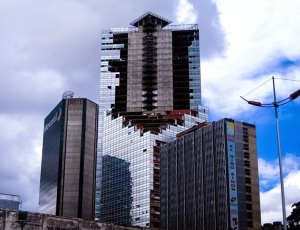Wistful about the Tower of David



Farewell to all that
I loved this piece by Boris Muñoz on the evacuation of the Tower of David. Painstakingly, Boris took the time to visit the Tower and get to know its residents. He went deep into their back stories, their fears and aspirations – why, he even got to go to a wedding at the Tower! (Which begs the question … what do you wear for a wedding at the Tower of David?)
What emerges is a microcosm of revolution and populism, crime and traffic, yearnings and despair. It’s quite something – kudos to Vocativ for having the patience to wait until a story like this emerges.
For those aspiring writers out there, notice as well how Boris masterfully evokes the feel for the place – the smells, the scenery, the people’s lives. Little details – things such as “[g]usts of wind blew candy wrappers across the building’s atrium” or the fact that Luiselmy Reinoso, a 31-year old resident, has five children – linger in the mind long after the piece is done. The architecture of the piece holds its own next to the building itself.
By conveying the lights and shadows of life in the tower, Boris seems to be conveying his own ambivalence toward the setting for such a great story. After all, the Tower may be a hell-hole, but what a treasure trove it has been for journalists. The demise of the Tower suddenly makes Caracas a little bit less interesting, just as the demise of the Revolution will inevitably (hopefully) make Venezuela a tad more normal.
And we all know journalists hate “normal.”
Followers of the tower story will be surprised to learn that “El Niño” Daza, the “leader” of the Tower that was the main subject of an extended piece by Jon Lee Anderson in the New Yorker last year, no longer lives in the Tower. According to a resident who spoke to Boris, Daza is in prison for unexplained reasons. Is he a political prisoner? What is he being charged with? Nobody knows. It’s one of those things that mysteriously happen in revolutionary Venezuela.
There really isn’t a standout part, but I found this one outstanding:
“Not all the Tower’s residents are poor, and the differences in wealth are obvious. On one visit, I bumped into Mayra Castillo, a 26-year old government employee with an undergraduate degree in education. Her husband works for Venezuelan state television, and the couple owns a car and a nice two-bedroom apartment with ceramic tiled floors.
They came to the Tower in 2011 because the nicer parts of the capital were too expensive. Since they moved into the building, they’ve spent thousands of dollars turning their apartment into a middle-class home. Because they both work normal business hours, moving outside the city will mean spending considerable time stuck in the capital’s notoriously bad traffic. But they still signed up for the move. “Buying an apartment in Caracas would cost more than $100,000,” Castillo said. “And there’s no way we could afford that.”
Other residents aren’t so fortunate. Carolina Moreno, 43, moved to the Tower in 2012. Previously, she lived with her husband in a four-bedroom house in a low-income neighborhood in the western part of the city. The couple owned a small security-guard company, which Moreno managed. Now she’s divorced and unemployed and takes care of her granddaughter. “We made good money until my husband left me and kicked me out of our business,” she said. “I ended up here, thanks to the pastor of my church.”
Moreno’s early life in the building wasn’t easy. And as we chatted on our way to her apartment, I could see she was holding back tears. “It was horrible at first,” she said. “Come and see the space I’m living in. I can’t call it a house.”
Moreno was living on the ground floor of the Tower in a tiny room she created between two hollow concrete pillars. The only light in her apartment came from a single 60-watt bulb hanging from a sewage pipe on the ceiling. Inside one pillar there was a two-ring stove beside a toilet bowl. Near the other pillar were a headboard, a mattress and a computer. These were all the belongings she had left from her marriage. “I try not to think about the way I’m living,” she said. “When I look at the cooking stove right next to the toilet bowl, I beg God to give me the strength to keep on living.”
Caracas Chronicles is 100% reader-supported.
We’ve been able to hang on for 22 years in one of the craziest media landscapes in the world. We’ve seen different media outlets in Venezuela (and abroad) closing shop, something we’re looking to avoid at all costs. Your collaboration goes a long way in helping us weather the storm.
Donate




